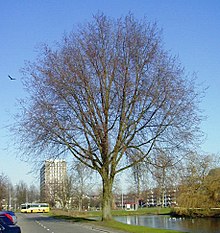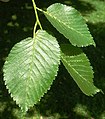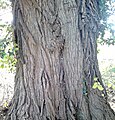Ulmus × hollandica 'Vegeta'
| Ulmus × hollandica 'Vegeta' | |
|---|---|
 'Vegeta', Groningen. | |
| Hybrid parentage | U. glabra × U. minor |
| Cultivar | 'Vegeta' |
| Origin | England |
Ulmus × hollandica 'Vegeta', sometimes known as the Huntingdon Elm,
The tree was given the
Description
In areas unaffected by
A distinguishing feature of 'Vegeta', according to Schneider (1906) and Mitchell (1974), is that the leaf margins to right and left of the petiole start from a vein, not from the midrib.[9][10][11] 'Vegeta'-type leaves from Hinchingbrooke Park collected by Heybroek in 1960 do not share this feature,[12] nor do some old 'Vegeta' cultivars in Oxford and Edinburgh (see ' 'Vegeta'-like cultivars', below). This unusual feature, however, clearly appears in the older cultivar, Chichester Elm,[13][14] and is frequently present in 'Vegeta' elsewhere (see gallery). If indeed the feature distinguishes Chichester from Huntingdon, the former may be more common in cultivation than currently believed, having over time been mis-called "Huntingdon". A 2013 DNA test of old Chichester elms (see under 'Cicestria') did not include a younger nursery-sourced "Huntington" as a "control".[15]
Elwes & Henry[3] and Bean[16] attested that 'Vegeta' suckers freely, but other writers have stated that it does not sucker at all.[6][17] This contradiction is almost certainly owing to methods of propagation: higher class nurseries grafted cuttings onto Wych Elm stock, which would not produce suckers, whilst others simply rooted the cuttings, which would. A comparatively high percentage of the seed is usually viable, but produces variable offspring.[16]
-
'Vegeta' leaves; note long petioles.Southsea Common
-
'Vegeta' leaves, Osney churchyard, Botley Road, Oxford
-
Underside
-
'Vegeta' foliage, North Merchiston Cemetery, Edinburgh
-
'Vegeta' bark; note lattice pattern
-
Bark of 'Vegeta', Inverleith Park, Edinburgh
-
'Vegeta' samarae, showing seed close to notch
-
'Vegeta' fruiting, The Meadows, Edinburgh
Pests and diseases
The tree was one of four European cultivars found by researchers in The Netherlands to be resistant to the initial strain of
Cultivation
The tree was widely planted in England, particularly between the end of the nineteenth century and the 1930s,
Owing to its resistance to the original strain of Dutch elm disease, 'Vegeta' was planted in large numbers across Amsterdam after the Second World War as a replacement for 'Belgica' (Belgian Elm), but was itself eventually replaced by the Dutch cultivar 'Dodoens' following the arrival of the more lethal strain of DED in the early 1970s.[27]
-
'Vegeta' in Royal Botanic Garden Edinburgh (1989)[28]
-
'Vegeta' in Hove Park, East Sussex
-
Wind-pruned 'Vegeta', Southsea Common, 2007
-
'Vegeta', autumn colours, Charlotte Square, Edinburgh
-
'Vegeta',Healesville, Victoria, 2010
-
'Vegeta' in Lincoln, 2016
Notable trees
The UK
In Wales, one very large tree (NT number 771, last recorded in 1995) stood in the grounds of
Notable plantings in Australia include the
'Vegeta'-like cultivars
F1 hybrids between Wych and Field Elm (e.g. Huntingdon Elm) are fully fertile, but produce widely variant progeny.[40] An elm at Magdalen College, Oxford, long believed to be a wych elm, then identified by Elwes as a 'Vegeta'-type hybrid, was for a time the largest elm known in Britain before it was blown down in 1911 (see under U. × hollandica). An old 'Vegeta'-type hybrid (girth 4.5 m) stands (2017) at the University College sports ground, Abingdon Road, Oxford.[41] Bean noted that hybrids similar to Huntingdon occur naturally in parts of east-central England and may have been raised by nurseries and distributed, and that the raising and distributing of cultivars from the seed of Huntingdon will have produced elms similar to, but not the true Huntingdon clone.[16]
-
Old 'Vegeta'-type hybrid, University College sports ground, Abingdon Road, Oxford (2017)
-
Bark of University College elm, Oxford
-
Autumn leaves of University College elm
-
U. × hollandica, Gayfield Square, Edinburgh
-
Bole of Gayfield Square elm
-
Leaves of Gayfield Square elm
A mature weeping elm survives (2010) near Actons Farm in the vicinity of the Rivers Nursery,
The weeping elm once grown at
Synonymy
- Ulmus huntingdonensis: Dieck (Zöschen, Germany) Haupt-catalog der Obst- und gehölzbaumschulen des ritterguts Zöschen bei Merseburg supplement 1, 1887, p. 28.
- Ulmus huntingdonii Hort.: Rehder, in Bailey, The standard cyclopedia of horticulture 6: 3411, 1917, in synonymy.
Hybrid cultivars
- NCCPG Elm Collection at Happy Valley Park, Woodingdean, and at the Wijdemeren City Council Elm collection in The Netherlands, five were planted on the Overmeerseweg and Dammerweg in Nederhorst den Berg in 2015.
Accessions
North America
- Holden Arboretum, US. Acc. no. 70–128
- Morton Arboretum, US. Acc. nos. 593–30, 71–70
- New York Botanical Garden, US. Acc. no. 529/89
- United States National Arboretum, Washington D.C., US. Acc. no. PI38492
Europe
- Bodnant Garden, Conwy, UK. No accession details.
- NCCPG Elm Collection [3]
- Hortus Botanicus Nationalis, Salaspils, Latvia. One tree, planted 1998, acc. no. 18127.
- Rainis Park, Liepāja, Latvia. Two trees, planted before 1994.
- Royal Botanic Garden Edinburgh, UK. Acc. no. 19699364
- Westonbirt Arboretum [4], Tetbury, Glos., UK. Two trees, one without planting date or acc. no., the other planted 2001, acc. no. 1999/118.
- Wijdemeren City Council, Netherlands. Elm Arboretum. 2 trees planted around 1970 Spiegelweg and 7 planted 2019 Randweg, Nederhorst den Berg.
Australasia
- Avenue of Honour, Ballarat, Australia. Details not known.
- Victoria, Australia. Details not known.
- Colac Botanic Gardens, Australia. Details not known.
- Eastwoodhill Arboretum [5], Gisborne, New Zealand. 3 trees, details not known.
- Fawkner Park, South Yarra, Australia. Details not known.
- Kyneton Botanic Gardens, Kyneton, Australia. Details not known.
- Royal Botanic Gardens, Melbourne [6], Australia
- Waite Arboretum [7], University of Adelaide, Adelaide, Australia. Acc. no. 336
Nurseries
Australasia
- Established Tree Transplanters Pty. Ltd., Victoria, Australia. [8]
Europe
References
- ^ BSBI List 2007 (xls). Botanical Society of Britain and Ireland. Archived from the original (xls) on 2015-06-26. Retrieved 2014-10-17.
- ^ John Ingram in The Gardeners' Chronicle, 1847, p.507, p.526
- ^ a b c Elwes, Henry John; Henry, Augustine (1913). The Trees of Great Britain & Ireland. Vol. 7. pp. 1879–1882.
- ^ Richens, R. H., 'Studies on Ulmus: IV. The village elms of Huntingdonshire', in Forestry 34 (1961), p.61-2
- ^ White, J. & More, D. (2002). Trees of Britain and northern Europe. Cassell, London.
- ^ Rackham, Oliver(1976). Trees and Woodland in the British Landscape. J. M. Dent, London.
- ^ ISBN 978-0-905637-15-0. Retrieved 2017-10-24.
- ^ "Herbarium specimen - L.1587039". Botany catalogues. Naturalis Biodiversity Center. Samarae and new leaves; labelled Ulmus hollandica 'Vegeta', Arnold Arboretum, 1930; "Herbarium specimen - WAG.1847067". Botany catalogues. Naturalis Biodiversity Center. Samarae and new leaves; labelled Ulmus × hollandica 'Vegeta', Baarn, 1962
- ^ Jobling & Mitchell, Field Recognition of British Elms, Forestry Commission Booklet (1974), p.19, fig.33
- ^ Schneider, Camillo Karl (1906). Illustriertes Handbuch der Laubholzkunde. 1. Jena G. Fischer. p. 215
- ^ "Herbarium specimen - L.3712162". Botany catalogues. Naturalis Biodiversity Center. Labelled Ulmus × hollandica 'Vegeta', 1968; "Herbarium specimen - L.1586885". Botany catalogues. Naturalis Biodiversity Center. Cultivated as U. vegeta (RBGE specimen); "Herbarium specimen - E00824827". Herbarium Catalogue. Royal Botanic Garden Edinburgh. Cultivated as U. vegeta (RBGE specimen); "Herbarium specimen 308706 herbariaunited.org" Sheet labelled Ulmus montana var. vegeta, Weston-super-Mare, Somerset, 1910, A. Ley; "Herbarium specimen 308705 herbariaunited.org" Sheet labelled Ulmus montana var. vegeta, Kew Gardens specimen, c.1910, A. Ley; "Herbarium specimen 309311 herbariaunited.org" Sheet labelled Ulmus montana var. vegeta, "Huntingdon Elm", Kew Gardens specimen, 1908, A. Ley
- ^ bioportal.naturalis.nl, specimen L.1582355 Hinchingbrooke Park leaves collected by Heybroek, 1960
- ^ Chichester Elm leaves, Queens' College Cambridge (1)
- ^ Chichester Elm leaves, Queens' College Cambridge (2)
- ^ Smith, Richard (2014). "The Elms in the grove". Queens' College Record: 28–29. Retrieved 7 December 2016.
- ^ a b c Bean, W. J. (1981). Trees and shrubs hardy in Great Britain, 7th edition. Murray, England.
- ^ Gurney, R. (1958). Trees of Britain. Faber & Faber, London.
- ^ "Les Ormes de France" (PDF). Revue de botanique appliquée et d'agriculture coloniale. 22 (254): 441. 1942.
- ^ Katalog (PDF). Vol. 108. Berlin, Germany: L. Späth Baumschulenweg. 1902–1903. pp. 132–133.
- ^ Ulrich, C. (1894), Katalog Drzew i Krezewow, C. Ulrich, Rok 1893-94, Warszawa
- ^ Hovey & Co., Boston, Mass., Catalogue of ornamental trees & shrubs, evergreens and climbing plants, 1855, p.5
- ^ Bobbink and Atkins, Rutherford. N.J. 1902. p. 51.
- ^ General catalogue, 1904 : choice hardy trees, shrubs, evergreens, roses, herbaceous plants, fruits, etc. New York: Frederick W. Kelsey. 1904. p. 18.
- ^ Welch, G. L. & Co. Plumfield Nurseries, catalog 1913. Plumfield Nurseries, Fremont, Nebraska.
- ^ Saunders, William; Macoun, William Tyrrell (1899). Catalogue of the trees and shrubs in the arboretum and botanic gardens at the central experimental farm (2 ed.). pp. 74–75.
- ^ Brookes, Margaret, & Barley, Richard, Plants listed in nursery catalogues in Victoria, 1855-1889 (Ornamental Plant Collection Association, South Yarra, Victoria, 1992), p.303–304
- ^ amsterdamsebomen.nl
- ^ RBGE herbarium specimen E00824827, data.rbge.org.uk
- ^ "Huntingdon elm felled in Higham Ferrers". 2014.
- ISBN 9781842464526.
- ^ Article on The Marylebone Elm, Trees for Cities web-page
- ^ "Google Street View - Yarborough Crescent". Google Street View.
- ^ "Google Street View - Brunswick Avenue". Google Street View.
- ^ Richard Bland, 'The Downs Observer' in The Bristol Six, March 2016, p.14
- ^ "Sheffield Huntingdon Elm to get Tree of the Year cash - BBC News". BBC News. Retrieved 2017-06-29.
- ISBN 0-7241-9962-4
- ^ Spencer, Roger, ed., Horticultural Flora of South-Eastern Australia, Vol. 2 (Sydney, 1995), p.112
- ISSN 0113-4132
- ^ Photograph of Huntingdon Elm, Point Erin Park, Herne Bay, New Zealand, bts.nzpcn.org.nz [1]
- ^ Richens, R. H. (1983). Elm. Cambridge University Press.
- ^ "Google Street View - Sunningwell Road". Google Street View.
- ^ Ingram, J. (1847). The Huntingdon Elm - Bates v. Rivers. Gardeners' Chronicle, 526.









!['Vegeta' in Royal Botanic Garden Edinburgh (1989)[28]](http://upload.wikimedia.org/wikipedia/commons/thumb/6/62/EDIN-BG-1989-01.A.jpg/82px-EDIN-BG-1989-01.A.jpg)










